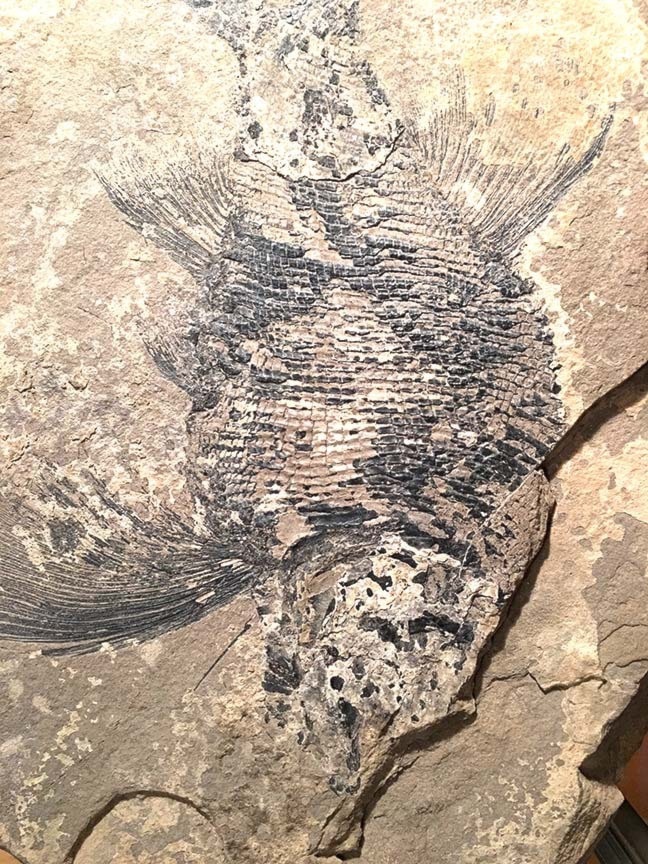Barry Coulter
Big news out of the deep past and the present are putting Cranbrook on the natural history map.
Wednesday evening, June 15, at the Cranbrook History Centre, at the CHC's ongoing lecture series on the East Kootenay's fossil heritage, two major announcements were made: One concerned the local discovery of an important discovery of a Triassic fossil site near Cranbrook. It was also announced Wednesday that the CHC has secured funding to develop the Centre's new paleontology gallery and research lab.
CHC Executive Director Char Murray is hoping this new facility — which will be key to the area’s growing importance as a fossil site — will be open next year.
The Wednesday meeting at the CHC featured a presentation by Dr. Robert Gaines, a researcher from Pomona College, Clarement California. Dr. Gaines along with research partner, Dr. Jean-Bernard Caron, are discoverers of the Kootenay National Park-Marble Canyon deposits, which is an extension of the Burgess Shale.
The series presented by the CHC is proving to be a popular draw. Murray said about 120 people turned out to take in Dr. Gaines’s lecture and to honour amateur paleontologist and local prospector Michel Plourde, who discovered the marine fossil site.
Plourde was told by a friend some 20 years ago, about a remote East Kootenay mountain location with fossil fish. Over the next decade, on free weekends, Michel would hike all day, sleep in the mountains and pack out big rocks in order to collect the Triassic-era fossils.
Fossil creatures he discovered so far include several different species of fish and an early marine reptile.
Plourde was concerned about the protection of the fossils and the fossil site itself, so he stacked up the fossils in his shed until he could be assured of their protection. He didn’t want to see the collection whisked away to a distant location as has happened with many of the important East Kootenay discoveries.
The advent of the natural history fossil exhibit at the Cranbrook History Centre has prompted Plourde to donate what may be likely one of the most significant private fossil donations in B.C. history. He has donated his entire collection to the CHC which will catalogue, preserve and curate and eventually display the specimens in the new gallery.
Wednesday evening, Cranbrook Mayor Lee Pratt presented Plourde with a plaque, recognizing his contribution.
CHC Director Guy Santucci described the international significance of the specimens.
“The Triassic age lasted from 251 to 199 million years ago,” he said. “Triassic fish are rare and [found] far apart. British Columbia is now poised to be on the world-wide forefront of these important fossils.
“The specimen’s ancestors survived following the great Permian extinction which wiped out 95 per cent of all life on earth,” Santucci said. “This is B.C.’s second site producing Triassic fish, the first being Wapiti Lake in northern B.C.”
The paleontological gallery and research is being helped into being by a Columbia Basin Trust grant $20,000 through the Columbia Kootenay Cultural Alliance. The City of Cranbrook also gave $10,000 towards the project, and the Cranbrook Archives, Museum And Landmarks Society (CAMAL), which oversees the History Centre, has kicked in $10,000.
In conjunction with a world class fossil display that includes unique local trilobite specimens, the CHC is examining the provisioning of the laboratory and research space, so that more researchers will be attracted to the area and conduct studies on other material available in the Kootenays.
The Cranbrook History Centre is generating public interest and momentum in local fossil heritage by inviting a number of world renowned researchers, such as Gaines, to speak of the local fossils and work that has been done in the East Kootenay region.
Jean Bernard Caron of the Royal Ontario Museum, and Gaines’ Burgess Shale colleague, will be at the next public lecture, July 21. Murray said he is specifically coming to talk about the Eager Formation out at Fort Steele, renowned for its trilobite fossil beds. The importance of the Eager Formation as a fossil site is perhaps yet to be fully realized.
“We all know about the Burgess Shale,” Murray said. “But the Eager Formation is 8 million years older than the Burgess Shale.
“A large part of Cranbrook’s history is these fossil beds,” she added. “People have been digging fossils for a long time in this area.”
